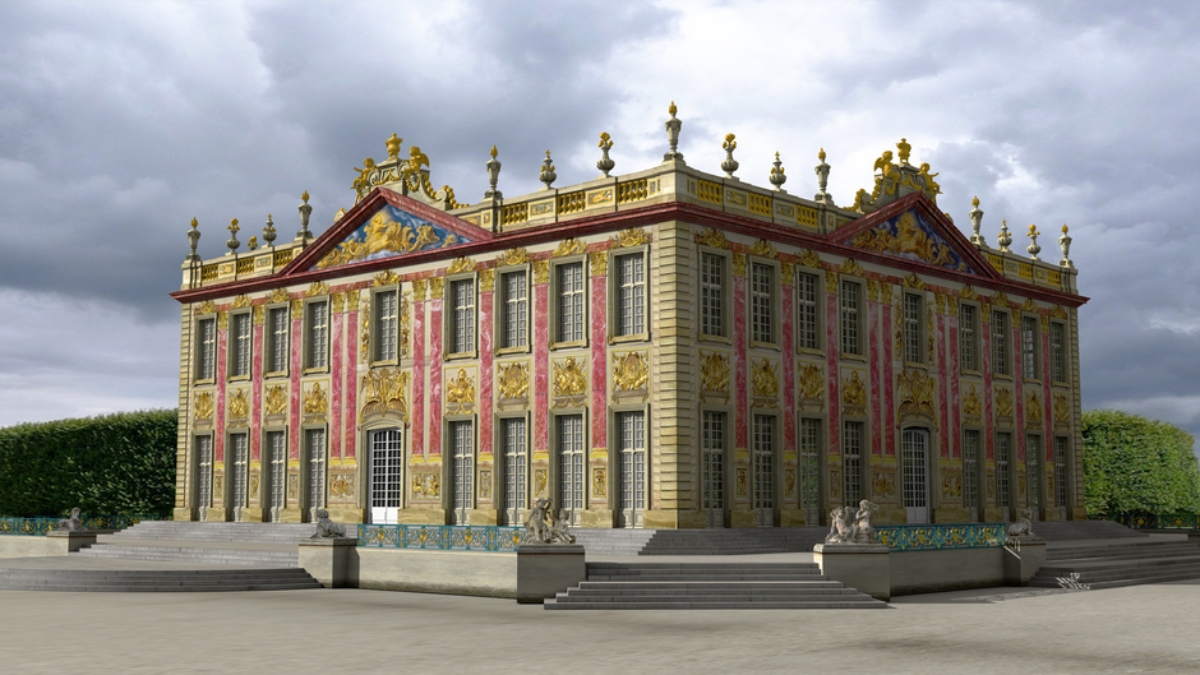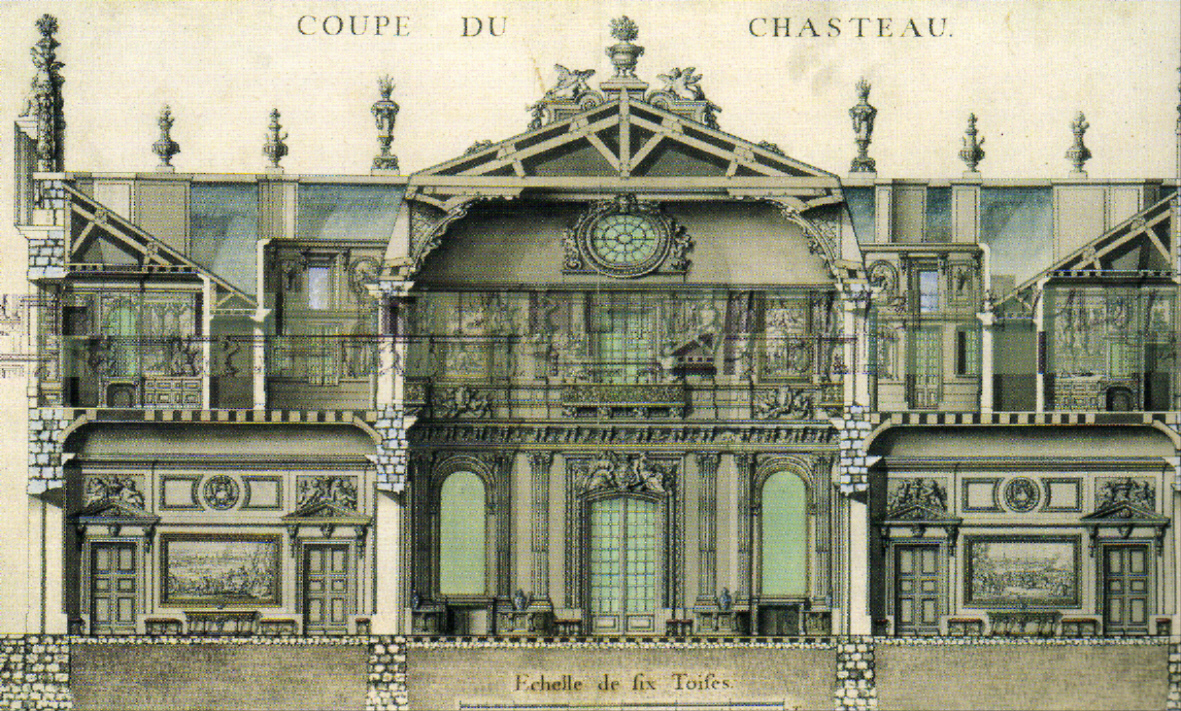While work was ongoing on Versailles, the Sun King set his sight on a far smaller - but far more exclusive - retreat for himself and his nearest and dearest. The plot chosen was located to the north of Versailles' park; as such, it was a secluded place, ideal for more intimate outings.
The idea was to create a space where only the king, chosen members of his family and favoured courtiers could indulge in a few days of respite from the throng of courtiers, commoners and soldiers usually found at court. Begun on 22 March 1679, the estate was the result of the cooperation between Mansart and Le Brun; their idea was to divide the château itself in a rather unusual way. Rather than having a single large palace to house all the guests, the building plan was split up. At the very centre would be the royal pavilion flanked on both sides by a total of 12 smaller pavilions (6 on each side) intended to provide housing for the chosen courtiers. The result was that the royal family lived together as a family in way that was simply not possible at Versailles.
 |
View of the royal pavilion at the centre
with the combined 12 smaller ones for invited
guests |
In true form, the pavilions were immediately dedicated to characters whose presence was already found in abundance at Versailles: Apollo (for the king's own pavilion), Hercules and Thetis as well Victory, Fame and Abundance.
As is clear from the painting above, the masterplan behind the king's new pleasure ground required water - and lots of it. However much like Versailles, the design chosen required a lot of water. Luckily for Marly, it had more natural sources than Versailles and would eventually supply water for the fountains of the palace. This meant that a complicated hydraulic system had to be invented, installed and tested before the château could finally inaugurated. It took five whole years for that process but the fountains successfully sprouted in 1684 with the king standing by to watch. As the fountains filled with water, so the earth was filled with flowers. Immense quantities of flowers were grown and transported to the parterres of Marly. John Dixon Hunt and Michel Conan illustrated how no less than 24 % of the flowers grown for the royal estates of Versailles went to Marly.
These two gentlemen has even provided us with the specific numbers of flowers concerned (see their book Tradition and Innovation in French Garden Art); amongst the deliveries to Marly, narcissi were by far the most dominant flower. 144.850 of them went to Marly along with 144 cases of tulips, 1.100 Spanish carnations, 1.075 irises etc. Like the greenhouses of Versailles, Marly's gardens were later chosen for the king's gardeners to grow especially rare and beautiful flowers.
Yet, it was not until 1686 - four years after the court moved to Versailles - that the buildings were finally finished enough to allow for the king to stay there. The wait was worth it: the pavilions and their lush gardens created a wonderful arena for the king to withdraw a bit from his own court.
 |
Reconstruction of the king's pavilion
( (c) Aristéas) |
The king's pavilion - recreated above - had four large apartments on the ground floor reserved for four people: the king, the queen, Monsieur and Madame. Each apartment was accorded its own colour scheme and was associated with a season; the king's was red for the summer, the queen's was green for the spring while Monsieur's apartment was orange for autumn and Madame's blue for winter. At the very centre was a large octagonal salon built in the "Italian" style. It was likely this particular salon which formed the center piece for the numerous entertainments and gambling nights.
 |
| Floor plan of the king's pavilion |
As can be seen from the floor plan above, the royal family were not the only ones to occupy the king's own pavilion. The first floor - left plan - was divided into a series of smaller apartments. Interestingly, the plan above indicate that Monsieur had been moved to the first floor while his apartment had been taken over by the Duchesse de Berry; meanwhile the queen's apartment was often lend out to the Grand Dauphin. Amongst those of the court who were given apartments on the first floor were the Duchesse du Lude, the Princesse de Conti, the Captain of the Bodyguard and several ladies of the court.
Note that the apartments on the ground floor was separated by salons of the same size - these were called Salons des Seigneurs and one housed a large billiard table.
In a rather ironic twist, Marly was meant to be a hunting château - located close to the hunting lodge-turned-palace of Versailles. The dense forests of the royal park ensured that game was plentiful and to ease the royal pastime, horses were moved there permanently. As the years went by the king - and his court - grew older. This required a few alterations such as wide paths through the park which allowed them to follow the hunt either in carriages.
Unlike the court at Versailles, Marly was a closed world. Only those invited especially by the king was allowed to reside there. But how to know if one was invited? In the true spirit of Versailles, even this became a ritual. For the gentlemen, they would approach the king after a hunt and simply ask "Sire, Marly?" - if the king approved, they were invited. If not, they were mortified. After a while, though, the king became tired of the constant questions. Instead, a list of the invited was drawn up by the king's trusted Bontemps and hung for all to see. It was generally a given that if a lady had been invited, she was entitled to bring her husband with her.
 |
| View of the royal pavilion |
Life at Marly was generally more relaxed than at court, although etiquette still reigned. However, to a regular at Versailles, it must have seemed down-right extraordinary. For instance, gentlemen were allowed to keep their hats on and everyone could sit down to gamble. Likewise, gentlemen were allowed to dine in the same room as the king - at Versailles the only man to ever be granted the honour of sharing the king's table was his brother. At Marly, the king ate at one table with the ladies while his son and grandsons entertained at other tables with the gentlemen. Several of the princesses were caught smoking pipes which the Swiss guards had provided them - after a thorough reprimand from their royal father that did not happen again.
Quiet gambling evenings, theatrical performances and promenades made up the more usual entertainment, interspersed with the rarer - but absolutely sublime - fêtes. One thing that stood out in particular about the festivities held at Marly was their sheer extravagance. Exotic themes mingled with more rural inspired tableaux as decorations and costumes changed; some would be considered less than politically correct today such as "Chinamen" or the Ottoman Sultans.
 |
Plan of the park of Marly (the king's
pavilion is the red square in the centre) |
While the entertainment was splendid, there appear to have been some complaints about the living conditions. For one, the pavilions were almost inhabitable in winter due to the complete lack of insulation. Yet the almost unrestricted closeness to the king enjoyed by those invited made up for such things. In all, the estate is estimated to have cost about 4,5 million livres. Marly became quite an expense for the royal treasury. Unlike at Versailles, the king picked up the bill for everyone involved - the guests were truly guests.
Even at Marly, the cares of state could not wait. While initially the château was intended only a pleasure house, a council chamber was soon made. During the War of the League of Augsburg, the king was kept regularly updated while staying there. The closeness to Versailles meant that sending a message would not take too long.
Courtiers were enchanted with the place; for one, the second Madame opined that Marly was much superior to Versailles. Undoubtedly, the increased relaxation and decreased number of people had a certain influence on that. Louis XIV himself never lost interest with his retreat. Throughout his life he would continue to make adjustments, embellish where he could and alter the things he no longer liked. By the end of his record-breaking reign, the Sun King spent a third of his time there.
Sadly, his enthusiasm for Marly was not shared by his successors. Neither Louis XV nor Louis XVI were enamoured with the place and let it largely go to waste. After the revolution, few of the buildings would remain and none of the magic that once reigned there.






No comments:
Post a Comment